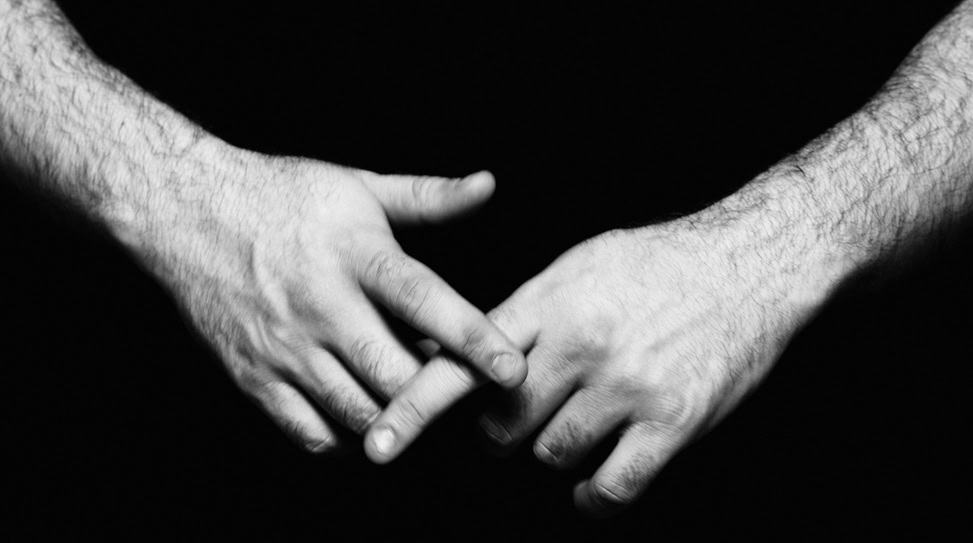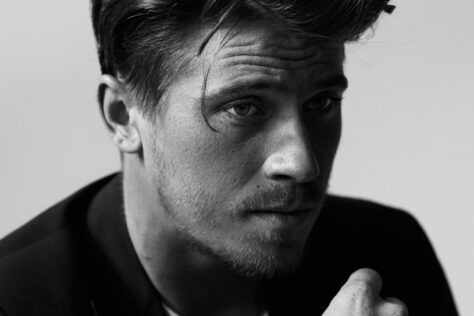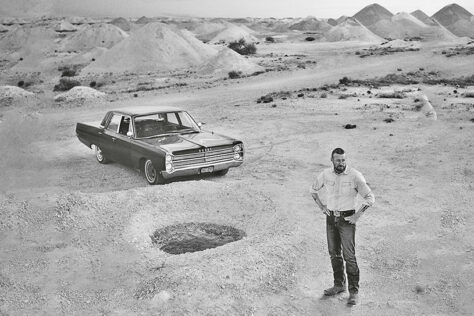Timothy Saccenti’s all-encompassing body of work—music videos, still photography, commercials, short films and fine art projects—is often brushed with heavy strokes of a certain surreal eeriness that lurks beneath a disarmingly beautiful and polished exterior. Consider the creative polymath’s videos for Battles’ “Atlas” and Blonde Redhead’s “Not Getting There,” for instance, where the bands are caught in a limbo between dream and reality. Saccenti’s methodical approach to lighting and production design work to build hyper-real landscapes that generate an abundance of atmosphere, which has now become his calling card.
And while Saccenti clearly has a propensity for producing artificial and highly processed images that don’t necessarily aim to depict a conventional reality, his unabashedly conceptual flourishes are surprisingly robust with intellectual rigor upon closer inspection. As he freely admits, science, literature and philosophy serve as fruitful sources of inspiration and form the essential basis for the construction of his images—a policy that serves him well. Never one to rest on his creative laurels for long, Saccenti continues to amass a growing list of impressive clients, among them Animal Collective, the Big Pink, Chairlift, Sony and Nike.
Anthem stopped by Saccenti’s Lower East Side studio recently to discuss the nature of dreams, New Yorkers running on survival mode, and his latest video for MNDR.
Head over to Green Label Sound for the premiere of MNDR’s “Cut me Out” video on March 30.
From a director’s standpoint, what would you say is the ideal scenario in which to start working on music videos with new artists/bands?
The best projects are when I get the opportunity to meet with an artist in person and we get to know each other beforehand to develop a connection. This is quite rare when it comes to music videos especially because everything tends to be very rushed. Normally, you write a treatment and don’t meet the artist until the day of the shoot. I like having the time to fall in love with certain aspects of their music and do this back-and-forth with ideas over the course of a month or two. Luckily, the artists I’ve worked with tend to have a keen visual sense in addition to their musical talent. It really does turn into a relationship and with that, there are the ups-and-downs that you’d find in a real relationship. I definitely try to work with tracks that are genuinely emotional or exciting to me because I have to live with it for months and months. That’s one of the reasons why my team and I have so little output as far as music videos go. Having too many projects of this nature on top of everything else that we’re doing would be the equivalent of being a creative polygamist.
You do a lot of commercial work.
Yes I do. It comes in-between the videos, still photography and other short film/fine art pieces. They all inform each other. My recent Blonde Redhead video featuring the horse-type mask with ponytail hair was actually an offshoot of a fine art project that I did in Tokyo. We applied some of the aesthetics from that project to the video. Commercially speaking, my work so far has tended to be built on a purely seductive visual basis rather than dialogue and as such, they tend to translate well into the commercial world without my having to sacrifice too much integrity—I hope.
Generally speaking, who’s your first point of contact when it comes to music videos? Is it the label, the commissioner or the artists/bands themselves?
Since I live in New York and see a lot of music shows and do photography, I’m often interacting with people who have a few degrees of separation from some of these artists and bands. Sometimes the artists reach out to me directly, but more often than not, the record labels approach me with projects that they think might fit my temperament. If there’s a new act that I’m excited about, I might seek them out myself as well. In the end, I’m really just a huge fan of music.
Just going back to Blonde Redhead, I remember seeing clips of their live shows where Kazu [Makino] is wearing the mask from the “Not Getting There” video. I guess she really liked it.
Kazu has this equestrian obsession and during the course of the project, more and more ideas about incorporating horses came into play. When we have shoots, I’ll often bring a lot of material that we’ve been exploring or experimenting with into our studio whether it’s an interesting piece of glass, filters or some unusual plant. We try to create an environment where the art director, lighting crew and I can have a very specific idea about what we want to accomplish, but also have all the tools in the room to change things very quickly on the spot if we need to. In this case, my art director Caroline Celis augmented the masks that we had previously made for our “Garden” project. Coincidentally, the manes on the masks are made from pony hair. Kazu responded very emotionally to them during the shoot and when she put it on, it seemed transcendent and became part of the video. As Blonde Redhead was working on the design for their live shows, which was in part based around the video as far as the lighting and theatrical elements are concerned, it became obvious to incorporate the mask. Our preferred working method is to create a world with its own rules and logic, and then allow spontaneous actions to happen. But to do this, you must gain the trust of the artist and your collaborators. There’s also a massive amount of intuition involved.
You and Kazu seem like-minded in a lot of ways.
As with a lot of these kinds of artists, music isn’t the only medium that they’re interested in. They’re often into things like Japanese theatre and ghost stories, for instance. It was a really natural process. You try to remain sensitive to what someone is magnetically attracted to for whatever reason and express that in a way that seems appropriate. You always strive to nurture an environment on set where spontaneity and emotion are allowed to roam freely.
It’s always interesting to hear how different directors come up with concepts for their videos. What’s your creative process like when you write treatments?
It’s fairly simple. I listen to the track in the dark on repeat, see what images appear and then write them down. As a person, I’m very curious about many subjects that have nothing to with music, videos or films. I’m into things like science, philosophy, the nature of reality and the study of dreams. I have amazing friends who are very inspiring and we discuss these subjects at length. So I try to keep an open mind when it comes to thinking about ideas for a particular track, but the themes are often already starting to apply to this world that I’m used to. Maybe a beat might sound like a red, 12-sided die floating in a tank of jellyfish; the free association of visual things. When I first heard “Peacebone” by Animal Collective, which we did a video for, my first notes were, “Pan-dimensional beings going on a date at an alternate reality drive-in movie theater”—whatever that means. I try to see what emotions come up and, synesthetically, what kind of visuals come to mind. I just write it all down without worrying about where it’s going to go. I really want to get down to the base emotion of each track.
Also, New York definitely plays an important role because, especially at night, there’s a lot of artificial lighting and atmosphere. From all the ideas that are cobbled together, my team and I then try to distill the concepts and feelings down to what seems purest. The artists I’ve worked with bring a huge amount to the table, though, and my job, generally, is to translate their world via my filter and show how it’s unique to them using all the techniques of film that are at our disposal. I guess my biggest challenge is trying to match something visually to the texture of a track, which is something that I’ve been obsessed with ever since I saw the video for Herbie Hancock’s “Rockit” when I was 8 years old.
Are you very influenced by New York in a broader sense as an artist?
I’m in close proximity to people who are very passionate about what they do here. There’s a system in New York where if you ‘re not trying to survive struggling to do something interesting, the city will purge you out very quickly. To a certain degree, New York isn’t bogged down by traditions of say, a place like Paris or London, and it doesn’t have the low-level of malevolence like you get in the industry in Los Angeles or, on the opposite spectrum of L.A., this sort of laissez-faire attitude. There’s always this feeling in New York that we’ve all sacrificed something to get here and there’s no backup plan, and because of that, it creates a nervousness, tension and excitement that I feel brings out the most creative aspects in people. So, to me, it’s a huge influence. New Yorkers sometimes take their access to galleries, films and music shows for granted, but you can live this life where you can do something inspiring every night of the week.
It’s also the confluence of various types of people in New York. I can walk to my street corner and see a young Puerto Rican girl wearing the flyest style of the week interacting with a 90-year-old Chinese woman pushing her cart of vegetables. You can’t make that shit up, it just happens. And you don’t have to drive here so you can get drunk with your friends and just walk or stumble home. [Laughs] But really, it’s the people of New York. Your friends are your family here and they’re constantly inspiring me.
Could you talk a little bit about your overall aesthetic? I don’t mean to put you in a box or anything, but there seems to be a connecting tread that ties your work together quite nicely, visually at least.
I’m not certain as I feel that my style is a bit schizophrenic, but perhaps there’s some sort of a thread of melancholic elements going on? I don’t know if that’s an ongoing theme in my work or just my emotional state. [Laughs] So many things influence you all the time that you’re almost embarrassed to admit to some of them. For me, a lot of my influences come from science. I wake up every morning and go on the New Scientist Web site. When I read articles about some mind-bending illusion or some new thing about dark matter—things that make my imagination run—there’s an excitement that keeps me going, not just for work but also in life in general. It’s a miserable world we live in so we have to make the best of it. [Laughs]
I try to incorporate as many things that I’m personally experiencing into my projects whether it’s the classics, love, feeling a sense of loss, existential dread, blood lust, sex… I’m drawn to things that are primal, I suppose. Although there’s this intellectual process to get to an endpoint, I try to pull back in order to get something that feels natural. I don’t necessarily mean something that’s shot naturally because I don’t think I would ever be accused of trying to capture reality, but I’ll always pick something that expresses emotion much more than reality.
As I’m quickly flipping through your personal notebook here, I’ve already caught the word “dream” at least 5 times. Do dreams count as a big influence?
I write down all of my dreams that I can remember. My dreams tend to be 50 hours long, so they wouldn’t work for a 3-minute video. [Laughs] I wouldn’t say that any particular dream has ended up in a project because, really, the project itself always has its own internal logic just like a dream does. Much like a dream has its own logic, you have to create a world with it’s own internal logic in videos that make sense in and of itself. Videos have their own rules and gravity, which explains why you watch stuff with too many disparate elements and it can feel jarring. Also, hearing about other people’s dreams is incredibly boring. [Laughs]
What was your approach for the new MNDR video?
With the MNDR video, the process got pretty complex and technical because we were using these Kinect systems, which we hacked. In a general sense, we wanted to have this character and expose the different layers of that character at a certain point. Maybe the message comes across somewhat heavy-handed, but she does cut the layers of her face off like an onion to reveal an interior self in the third act of the video. We worked off of her existing aesthetic, which had a lot to do with keeping things as analogue as possible. I worked with Ivan Safrin, a visual artist who I’ve collaborated with on many projects. He had been hacking these Kinect systems and we nerded out on that. We love breaking things open and putting them back together the wrong way. The Kinect seemed like a good match for her music, which is pop and modern, and also has this rebellious esoteric-ness to it. The idea of hacking a major name brand video game accessory to film the video worked very well conceptually. And even though other artists have done this recently, we felt that it matched the concept enough to work as a textual element in the piece. We filmed her performance and used the Kinect to capture the footage, then worked with the Kinect footage—also projecting it with some holographic screens—in which she would perform with herself in real time so it sort of looks like she’s doing a duet with herself. You have to see it to really understand what I’m talking about. [Laughs]
Were you familiar with MNDR prior to working together?
We had worked together on a photo shoot prior to doing this video and I was a fan of hers. On an intellectual and aesthetic level, we got along very well when we first met. We shared a lot of similar influences as far as early video and conceptual video art goes. She’s also very much into this world of analogue and synthesizers, things that I’m also very interested in from the 60s and even earlier than that. We had been talking about doing a video project together maybe on-and-off for about a year, but weren’t sure what that would be exactly. With this single “Cut Me Out,” her team approached me to write on it.
How involved was she from the video’s conception to execution?
She’s New York-based so it was easy for us to keep in touch. During the earlier stages of the video, we went back-and-forth to discuss ideas and what we liked and disliked about them. I would say that she’s very hands-on in that she’s excited about things. She wanted to make the video great and was willing to put all of her time into it but she has a lot of trust in the people that she works with and she’s never controlling. She’s willing to fight the label for you if any issues come up. At this point in the game where we’re in post-production, she’s put all of her trust in me to finish it while she’s traveling the world being famous. [Laughs]

 Clarion Call: Garrett Hedlund
Clarion Call: Garrett Hedlund A Conversation with Simon Baker
A Conversation with Simon Baker
No Comments